In this content we are discussing 10 important types of rabbit. Rabbits are charming and diverse creatures, have captured human fascination for centuries. With over 60 recognized breeds, they exhibit an array of sizes, colors, and personalities. From the compact Netherland Dwarf to the majestic Flemish Giant, the world of rabbits is a vibrant tapestry of nature’s creativity.
These herbivorous mammals are cherished as both pets and working animals, captivating us with their distinctive twitching noses, expressive ears, and gentle nature. Rabbits are social animals, forming bonds with humans and fellow rabbits alike. Their unique behaviors, such as hopping and binkying, add to their endearing charm.
Whether kept indoors or in outdoor hutches, proper care, attention, and a suitable environment are vital to ensuring their well-being. In this exploration of 10 important types of rabbit, we will delve into their captivating diversity, shedding light on their characteristics and fostering a deeper understanding of these delightful companions.
10 Important Types Of Rabbit!
1. Netherland Dwarf:
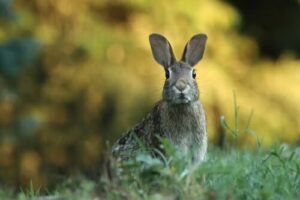
The Netherland Dwarf is a captivating and adorable breed of rabbit cherished for its diminutive size and charming appearance. Originating in the Netherlands, these tiny rabbits have captured the hearts of animal lovers worldwide. Weighing just two to two and a half pounds when fully grown, Netherland Dwarfs are among the smallest domestic rabbit breeds.
Their petite stature is accompanied by round faces and compact bodies, creating an irresistible and endearing visage. Their expressive eyes and tiny, upright ears contribute to their overall cuteness. Netherland Dwarfs come in an extensive array of colors and patterns, including solid, broken, and shaded varieties, adding to their visual appeal.
Despite their size, Netherland Dwarfs possess vibrant personalities. They are known for their energetic and curious nature, often engaging in playful behaviors that bring joy to their owners. These rabbits can form strong bonds with their human caregivers and thrive in loving and attentive environments.
Caring for Netherland Dwarfs requires special consideration due to their size. Providing appropriate living space, a balanced diet, and regular grooming is essential for their well-being. Due to their popularity as pets, Netherland Dwarfs can be found in various pet stores and from reputable breeders.
2. Flemish Giant:
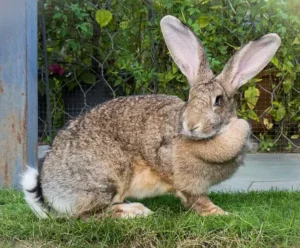
The Flemish Giant, a remarkable and impressive breed of rabbit, stands as a testament to nature’s diversity. Originating in Belgium, these gentle giants are renowned for their extraordinary size and calm disposition. Weighing in at around 14 to 16 pounds or even more, the Flemish Giant holds the title of the largest rabbit breed.
Characterized by their majestic appearance, Flemish Giants possess sturdy bodies, powerful limbs, and distinctive, upright ears. Despite their imposing size, these rabbits are known for their docile and friendly nature, making them popular choices for both pet owners and enthusiasts.
Their thick, dense fur comes in a variety of colors, including black, blue, fawn, and more, adding to the breed’s allure. While their primary purpose historically was meat and fur production, the Flemish Giant has found a special place in the hearts of rabbit lovers, standing out as a unique and captivating companion.
Proper care and attention are paramount for these gentle giants. Providing a spacious and comfortable living environment, a well-balanced diet, and regular exercise contribute to their overall well-being. While their size may be imposing, the Flemish Giant’s loving temperament and affectionate nature make them wonderful additions to families willing to invest in their care.
30 Amazing Facts About Deer And Types
3. Mini Rex:
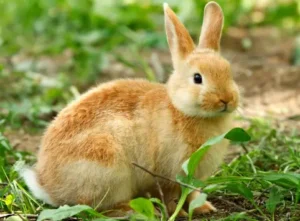
The Mini Rex is a delightful rabbit breed cherished for its charming appearance and luxurious fur. These compact rabbits are adored for their velvety, short fur that has a plush texture resembling that of velvet, making them incredibly soft to the touch. The Mini Rex’s fur comes in an array of stunning colors and patterns, adding to their visual appeal.
Renowned for their friendly and inquisitive nature, Mini Rex rabbits make wonderful companions for individuals and families alike. They have an affectionate disposition and often enjoy interacting with humans, making them a joy to handle and care for. Their compact size, coupled with their endearing personality, makes them a popular choice for both beginner and experienced rabbit enthusiasts.
Mini Rex rabbits are relatively low-maintenance in terms of grooming. Due to their short fur, they don’t require extensive brushing like some other long-haired breeds. However, regular interaction and handling are important to maintain their social and affectionate nature.
Whether kept as house pets or in outdoor hutches, Mini Rex rabbits thrive in environments that provide them with ample space to hop, explore, and exhibit their natural behaviors. With their delightful combination of soft fur, charming demeanor, and manageable care requirements, Mini Rex rabbits continue to capture the hearts of rabbit lovers around the world.
4. Holland Lop:
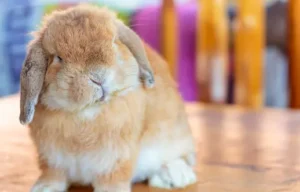
The Holland Lop, a breed cherished for its irresistible charm, captures hearts with its endearing appearance and gentle demeanor. Recognized for its distinctive feature – the adorable drooping ears that give it an eternal “aww” factor – the Holland Lop is a compact and delightful companion.
Weighing around 2-4 pounds, these petite rabbits possess a sturdy and well-proportioned body. Their plush fur comes in an array of colors and patterns, adding to their visual appeal. Despite their diminutive size, Holland Lops exude a personality that’s anything but small. They are known for their friendly and affectionate nature, making them ideal pets for families and individuals alike.
Holland Lops thrive on human interaction and are often described as social butterflies. They form strong bonds with their human caregivers and enjoy being cuddled and held. Their curious and playful demeanor adds to their charm, as they explore their surroundings with boundless energy.
When caring for a Holland Lop, providing a suitable environment with space to hop around and explore is essential. Regular grooming is necessary to maintain their fur’s health and prevent matting.
Whether you’re an experienced rabbit enthusiast or a newcomer to the world of bunnies, the Holland Loop’s captivating personality and distinctive appearance make it an enchanting addition to any home, bringing joy and companionship to those fortunate enough to share their lives with these delightful creatures.
The 20 Most Amazing Birds In Virginia! (2023)
5. Angora Rabbit :
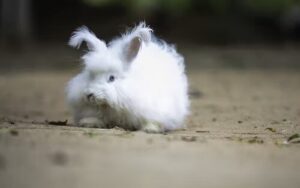
The Angora rabbit is a captivating breed revered for its luxurious and distinctive coat, which is composed of fine, silky fibers that resemble soft, fluffy clouds. This breed’s origins can be traced back to the city of Ankara, in present-day Turkey, where its name originates. Known for their elegant appearance, Angora rabbits have become cherished for their remarkable fur that comes in various types, including English, French, and Satin.
The hallmark of the Angora rabbit is its long, lustrous fur, which requires regular and meticulous grooming to prevent matting and maintain its health and quality. This grooming ritual not only keeps the rabbit comfortable but also creates an intimate bond between the rabbit and its caregiver.
Angora rabbits possess friendly and docile personalities, making them delightful companions for dedicated caretakers. Their gentle nature and tendency to form strong bonds with humans make them popular choices among rabbit enthusiasts and pet owners alike.
Due to their specialized grooming needs, Angora rabbits are often favored by those who are passionate about fiber arts, such as knitting and spinning. Their meticulously harvested fur can be spun into exquisite yarns, resulting in exceptionally soft and warm garments.
In conclusion, the Angora rabbit stands as a testament to nature’s elegance, offering a combination of beauty, companionship, and functional utility through its luxurious fur. Caring for an Angora rabbit requires commitment and attention, but the rewards of sharing a bond with this enchanting creature and creating exquisite textiles are well worth the effort.
6. Lionhead Rabbit:
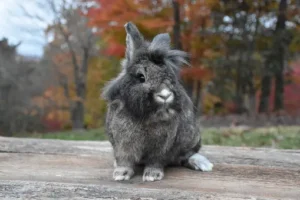
The Lionhead rabbit is a captivating and endearing breed known for its distinctive appearance and friendly nature. Named after the impressive “mane” of longer fur around its head, reminiscent of a lion’s mane, this breed’s appearance is truly enchanting. Lionheads have a compact and well-rounded body, complemented by their expressive eyes and often docile expression.
Originating in Europe, specifically in Belgium, the Lionhead rabbit has gained popularity around the world as an affectionate and sociable companion. Their gentle temperament makes them an excellent choice for families and individuals alike. Lionheads are known for their playful and curious nature, enjoying interactions with both humans and fellow rabbits.
One of the most appealing features of the Lionhead breed is its luxurious coat, which comes in a variety of colors and patterns. This fur requires regular grooming to maintain its softness and prevent matting, making it a wonderful bonding activity between the rabbit and its owner.
Despite their longer fur, Lionheads are relatively small in size, making them suitable for indoor living. Their charming appearance and engaging personality have contributed to their popularity as both pets and show rabbits. Whether you’re a seasoned rabbit enthusiast or a first-time owner, the Lionhead rabbit promises an enchanting and heartwarming companionship that is sure to bring joy to any household.
7. Rex Rabbit:
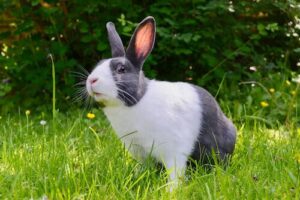
The Rex rabbit is a distinctive breed admired for its luxurious and velvety fur, setting it apart from other rabbit types. The Rex’s fur is remarkably soft to the touch, creating a delightful tactile experience for those who interact with it. This unique coat texture is a result of a genetic mutation that causes the guard hairs to be shortened, leaving only the soft undercoat. As a result, the fur lacks the typical “guard hair” layer found in most rabbits.
Rex rabbits come in a wide array of colors, providing a visually appealing spectrum for enthusiasts. The dense fur and vibrant hues contribute to their popularity as both pets and show animals. Beyond their striking appearance, Rex rabbits are known for their friendly and social personalities. They often form strong bonds with their human caregivers, making them enjoyable companions.
Caring for a Rex rabbit involves regular grooming to maintain the health and quality of their fur. Brushing helps prevent matting and keeps their coat in optimal condition. Their playful and curious nature also requires mental stimulation and space to explore.
Due to their appealing characteristics and eye-catching fur, Rex rabbits have found their way into the hearts of rabbit enthusiasts around the world. Whether as cherished pets or admired show animals, Rex rabbits continue to captivate with their softness, charm, and engaging personalities.
8. Himalayan Rabbit:
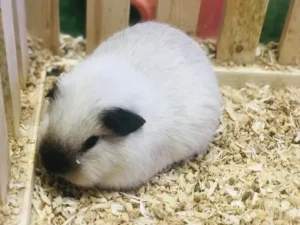
The Himalayan Rabbit, a breed admired for its striking appearance, draws its name from the majestic Himalayan mountains due to its coloration reminiscent of the famed Himalayan Siamese cats. With its distinct color points and stunning contrast, the Himalayan Rabbit exhibits elegance and charm.
These rabbits have a pure white coat, with striking coloration restricted to their extremities – their ears, nose, feet, and tail. This color pattern is a result of a temperature-sensitive enzyme that causes pigmentation to develop in cooler areas of their body. The fur on their bodies remains white due to the warmer temperature.
Himalayan Rabbits are known for their calm and friendly temperament, making them ideal companions for families and individuals alike. Their gentle nature allows them to form strong bonds with their human caregivers. They enjoy interaction and are often content to be held and petted.
In terms of care, Himalayan Rabbits require regular grooming to maintain their clean and beautiful appearance. Their striking coat demands attention to avoid matting and keep it in pristine condition. A balanced diet, proper housing, and regular veterinary care contribute to their overall well-being.
Whether as pets or show animals, Himalayan Rabbits enchant with their captivating beauty and endearing personalities. Their unique coat and charming disposition make them a delightful addition to any rabbit enthusiast’s life.
9. Dutch Rabbit:
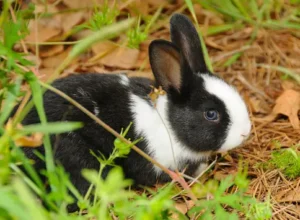
The Dutch Rabbit, a charming and distinct breed, captures hearts with its striking appearance and engaging personality. Recognized by its characteristic white blaze running down the center of its face, it presents a captivating contrast against its richly colored body. This breed’s vivid and well-defined markings, often accompanied by a harmonious blend of hues, make it a visual delight for rabbit enthusiasts.
Dutch Rabbits are of medium size, with a compact and well-proportioned body. Their short, glossy fur showcases an array of color combinations, including black, blue, chocolate, gray, and more. Their expressive eyes exude intelligence and curiosity, reflecting their inquisitive nature.
Beyond their appealing aesthetics, Dutch Rabbits are known for their friendly and sociable temperament. They possess an endearing curiosity, often engaging in playful antics that charm both children and adults alike. Their affectionate disposition makes them wonderful companions, particularly for those new to rabbit ownership.
Dutch Rabbits thrive on interaction and mental stimulation, enjoying supervised playtime and gentle handling. Providing a spacious and enriching environment is essential to ensure their well-being. Regular grooming sessions help maintain their sleek appearance and promote a healthy coat.
Whether kept as pets or admired in rabbit shows, Dutch Rabbits leave an indelible impression with their distinctive appearance and delightful demeanor. As both an embodiment of beauty and a loving companion, the Dutch Rabbit continues to captivate hearts with its timeless appeal.
10. Mini Lop:
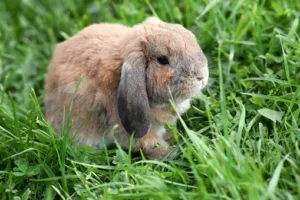
The Mini Lop, a delightful and charming rabbit breed, has captured the hearts of pet enthusiasts around the world. With their endearing lop ears that frame their expressive faces, Mini Lops are a visual treat, radiating cuteness and charisma. These small to medium-sized rabbits possess a friendly and affectionate demeanor, making them ideal companions for families, children, and individuals alike.
Originating from the selective breeding of larger Lop breeds, Mini Lops maintain the signature lop ear trait while being more compact in size. Their dense, plush fur comes in a wide array of colors and patterns, adding to their visual appeal. Their coat requires regular grooming to ensure its health and maintain its soft texture.
Mini Lops thrive on human interaction and socialization, often forming strong bonds with their caregivers. Their playful nature and gentle disposition make them approachable and well-suited for indoor living. These inquisitive rabbits enjoy exploring their surroundings, hopping around, and engaging in various activities that stimulate their minds and bodies.
Whether you’re a seasoned rabbit enthusiast or a first-time pet owner, the Mini Loop’s manageable size, adorable appearance, and affectionate personality make them an excellent choice for those seeking a loving and engaging companion. Providing proper care, a safe environment, and ample opportunities for interaction will ensure that your Mini Lop thrives as a cherished member of your family.
Diet Of Rabbits:
A proper diet is crucial to maintaining the health and well-being of rabbits. Here’s an overview of the dietary needs of rabbits:
- Hay: Hay should form the foundation of a rabbit’s diet. High-fiber grass hays, such as timothy, orchard grass, and brome hay, help maintain healthy digestion, prevent dental problems, and keep rabbits mentally stimulated.
- Fresh Vegetables: Offer a variety of fresh, rabbit-safe vegetables daily. Leafy greens like romaine lettuce, kale, spinach, and herbs like parsley are excellent choices. Introduce new vegetables gradually to avoid digestive upset.
- Pellets: High-quality rabbit pellets should be limited in quantity. Choose pellets with high fiber content and low protein, avoiding those with added sugars, seeds, or colorful pieces.
- Fresh Water: Clean, fresh water should always be available. Use a heavy water bowl or a sipper bottle that rabbits can easily access.
- Treats: Treats should be given sparingly, as excessive treats can lead to obesity and other health issues. Safe treats include small portions of fruits like apples, berries, and carrots.
- Avoid: Avoid high-sugar, high-starch foods, as well as foods that are toxic to rabbits, such as chocolate, caffeine, onions, and garlic. Iceberg lettuce is also best avoided due to its low nutritional value.
- Feeding Guidelines: The general guideline is to feed approximately 70-80% hay, 10-15% vegetables, and a small amount of pellets (around 1/4 to 1/8 cup per 5 pounds of body weight) daily. Adjust portions based on the rabbit’s size, age, activity level, and health status.
- Timed Feeding: Consider timed feeding to prevent overeating. Feed hay and vegetables multiple times a day, and limit pellets to once a day.
- Dental Health: Rabbits’ teeth continuously grow, so a proper diet with sufficient hay helps maintain good dental health.
- Gradual Changes: Introduce new foods gradually to prevent digestive issues. Monitor your rabbit’s weight and adjust portions as needed.
Always consult a veterinarian knowledgeable about rabbit care to ensure you’re providing the right diet for your specific rabbit’s needs. A balanced diet, along with a safe and clean environment, contributes to a happy and healthy rabbit.
Diseases Of Rabbits:
- Rabbit Hemorrhagic Disease (RHD): A highly contagious and often fatal viral infection that affects the liver and other organs.
- Myxomatosis: Another viral disease transmitted by insects, causing severe swelling of the eyes, nose, and genitals. It is often fatal.
- Pasteurellosis: Caused by the bacterium Pasteurella multocida, it can lead to respiratory and other infections.
- Coccidiosis: A parasitic infection affecting the intestinal tract, leading to diarrhea and other digestive issues.
- Encephalitozoonosis: A microsporidial infection that can cause neurological symptoms, kidney damage, and other health problems.
- Hairballs: Rabbits are prone to forming hairballs in their digestive tract, which can lead to blockages.
- Respiratory Infections: Rabbits can develop infections like snuffles (Pasteurellosis) that affect the respiratory system.
- Gastrointestinal Stasis: Also known as “GI stasis,” it’s a condition where the digestive system slows down or stops functioning, often due to a poor diet.
- Ear Mites: These tiny parasites can cause discomfort and irritation in a rabbit’s ears.
- Dental Problems: Rabbits’ teeth continuously grow, and malocclusion (misaligned teeth) can lead to dental issues.
- Abscesses: Infections can result in painful abscesses that require medical attention.
Treatment Of Rabbit’s Diseases:
The treatment of rabbit diseases varies depending on the specific illness and its severity. It is essential to consult a veterinarian who specializes in rabbit care for proper diagnosis and guidance. Here’s a general overview of how different rabbit diseases might be treated:
- Viral Diseases (e.g., RHD, Myxomatosis): Unfortunately, there are often limited treatment options for viral diseases. Supportive care, including maintaining proper nutrition, hydration, and keeping the rabbit comfortable, may be the main focus. Vaccination is essential for prevention, where available.
- Bacterial Infections (e.g., Pasteurellosis): Bacterial infections may be treated with antibiotics prescribed by a veterinarian. Long-term management and supportive care may be necessary for chronic cases.
- Parasitic Infections (e.g., Coccidiosis, Ear Mites): Parasitic infections are typically treated with appropriate medications, such as antiphrastic drugs. Environmental cleaning and good hygiene practices can also help prevent reinfestation.
- Gastrointestinal Issues (GI Stasis): Treatment may involve medication to stimulate gut motility, pain relief, fluid therapy, and dietary adjustments. Critical cases may require hospitalization for intensive care.
- Dental Problems: Dental issues may require dental procedures to trim overgrown teeth and alleviate discomfort. A proper diet with adequate fiber can help prevent dental problems.
- Respiratory Infections: Antibiotics may be prescribed to treat respiratory infections. Keeping the rabbit in a clean and well-ventilated environment is crucial for recovery.
- Abscesses: Treatment involves draining and cleaning the abscess, along with appropriate antibiotics. Surgical removal may be necessary for larger or recurrent abscesses.
- Nutritional Disorders (e.g., Hairballs): Treatment includes a high-fiber diet, medications to promote gut motility, and encouraging water intake to prevent and manage hairballs.
Remember, self-medicating rabbits can be dangerous and may worsen the condition. Always consult a veterinarian experienced in rabbit care before administering any treatment. Providing a stress-free and comfortable environment, maintaining a proper diet, and offering regular veterinary check-ups are vital for preventing and managing rabbit diseases effectively.
Conclusion:
In exploring these 10 important rabbit types, we’ve uncovered a diverse world of companionship. From the enchanting Netherland Dwarf to the majestic Flemish Giant, each breed brings its own unique charm. Whether it’s the soft velvety fur of the Mini Rex or the distinctive markings of the Dutch Rabbit, these furry friends enrich our lives. Remember, choosing the right rabbit requires understanding their traits and needs. Whichever type you choose, a bond of love and care will undoubtedly blossom, creating a rewarding journey with these remarkable creatures.
FAQ’s:
What are some popular small rabbit breeds among the 10 important types?
Among the featured breeds, the Netherland Dwarf and Mini Rex are notable for their compact size and charming appearances.
Are there any giant rabbit breeds in the list of 10 important types?
Yes, the Flemish Giant is one of the showcased breeds, known for its impressive size and gentle temperament.
Do these rabbit breeds have different care requirements?
Yes, each breed may have specific care needs, including diet, exercise, and grooming. It’s important to research and understand the unique requirements of the breed you choose.
Can I keep these rabbit breeds together in the same enclosure?
While some rabbits can coexist peacefully, it’s crucial to introduce them gradually and monitor their interactions. Rabbits have distinct personalities, and compatibility varies.
Which breed is best for families with young children?
Breeds like the Mini Lop and Holland Lop are often recommended for families due to their friendly nature and manageable size, making them great companions for children under supervision.
Must Visit: Vetpomedix.com


